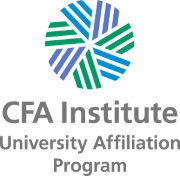Economics of Information
Economics of Information
ΧΡΟΤΠ 01
ECTS: 7.5
Course Type: Elective
Semester: Spring
Teaching Hours: 4
Prerequisites:
Course Scope
After completing the “Information Economics ” course, students are expected to:
• Describe the different aspects of the market efficiency hypothesis
• Understand the concept of asymmetric information
• Describe the concept of market failure
• Distinguish between the primary and secondary markets
• Analyse the relationship between asymmetric information and the bid-ask spread in the organized market
• List the different manifestations of the concept of asymmetric information in the market such as front running
• Recognize the relationship of market efficiency in terms of information and the existence of information costs in the organized market
Course Outline
The course purpose is to present the concept and role of information in the context of the market microstructure literature. The course introduction includes the definition of an organised (primary and secondary) market, the equilibrium of a market under conditions of complete information and the equilibrium under asymmetric information (market participants with different information sets). Among others, the following key concepts will be examined:
• The different forms of market efficiency (special focus on informational efficiency)
• The concept of asymmetric information (Stiglitz [22])
• Market failure (Akerlof [1])
• Private and public information
• The concept of market microstructure (O’Hara [17], Hasbrouck [13])
• The relationship between asymmetric information in the context of the secondary market
• The relationship between information, market efficiency and price disclosure (Grossman & Stiglitz [12], among others).
• Algorithmic trading and high-frequency trading (O’Hara [18])
• High-frequency transactions and the Grossman & Stiglitz [12] paradox (Stiglitz [21]).
• The different manifestations of asymmetric information in the market, including front running, insider trading, predatory trading, trading on rumors, etc. (Brunnermeier [4], Brunnermeier & Pedersen [6] among others)
• The relationship between asymmetric information and market liquidity (Foucault et al. [9])
In this context, a series of market microstructure models that include the concept of asymmetric information will be analyzed in detail. Interest will be focused on (simultaneous or sequential) trading asymmetric information models ((Kyle [15]) and (Glosten & Milgrom [10]) respectively). The role of liquidity and asymmetric information in the 2008 Global Financial Crisis of 2008 (Gorton & Metrick [11]) will be examined also as well as in the recent reform process of the key benchmark rates (USA, Eurozone, United Kingdom, Japan, etc.)( Duffie & Stein [8]).
Suggested Reading
1. Akerlof, G. A. (1970). The market for” lemons”: Quality uncertainty and the market mechanism. The Quarterly Journal of Economics, 488-500.
2. Athens Stock Exchnage, (2015). The Athex Rulebook, Athens Stock Exchnage, Athens
3. Barberis, N., & R. Thaler, (2002). A Survey of Behavioral Finance, NBER Working Paper No. 9222
4. Brunnermeier, K. M., (2001). Asset Pricing under Asymmetric Information: Bubbles, Crashes, Technical Analysis and Herding, Oxford University Press, Oxford
5. Brunnermeier, K. M., (2009). Bubbles, The New Palgrave Dictionary of Economics, (Edited by S. Durlauf and L. Blume), (2nd edition), Palgrave Macmillan, New York
6. Brunnermeier, M. K., & Pedersen, L. H. (2005). Predatory trading. The Journal of Finance, 60(4), 1825-1863.
7. Cartea, Á., Jaimungal, S., & Penalva, J. (2015). Algorithmic and high – frequency trading, Cambridge University Press, Cambridge
8. Duffie, D., & Stein, J. C., (2015), Reforming LIBOR and other financial market benchmarks, Journal of Economic Perspectives 29(2), 191-212
9. Foucault, T., Pagano, M., & Roell, A., (2013). Market liquidity: theory, evidence, and policy. Oxford University Press, Oxford
10. Glosten, L. R., & P. R. Milgrom, (1985). Bid, Ask and Transaction Prices in a Specialist Market with Heterogeneously Informed Traders. Journal of Financial Economics, Vol. 14(1), 71-100
11. Gorton, G., & Metrick, A. (2012). Securitized banking and the run-on repo. Journal of Financial Economics, 104(3), 425-451.
12. Grossman, S. J., & Stiglitz, J. E. (1980). On the impossibility of informationally efficient markets. The American Economic Review, 70(3), 393-408.
13. Hasbrouck, J., (2007). Empirical Market Microstructure: the Institutions, Economics, and Econometrics of Securities Trading, Oxford University Press, Oxford
14. Kindleberger, P. C., & R.Z. Aliber, (2005). Manias, Panics and Crashes: A History of Financial Crises, Palgrave–MacMillan, New York
15. Kyle, S. A., (1985). Continuous Auctions and Insider Trading, Econometrica, Vol. 53, 1315-1336
16. Lehalle, C. A., & Laruelle, S. (Eds.). (2013). Market microstructure in practice. World Scientific, Singapore
17. O’Hara, M., (1997). Market Microstructure Theory, Blackwell Publishing, Oxford
18. O’Hara, M. (2015). High frequency market microstructure. Journal of Financial Economics, 116(2), 257-270.
19. Rodrik, D. (2015). Economics Rules: Why Economics Works, when it Fails, and how to Tell the Difference. Oxford University Press, Oxford
20. Roll, R. (1984). A simple implicit measure of the effective bid-ask spread in an efficient market. The Journal of Finance, 39(4), 1127-1139
21. Stiglitz, J. E. (2014). Tapping the brakes: Are less active markets safer and better for the economy? In Federal Reserve Bank of Atlanta 2014 Financial Markets Conference Tuning Financial Regulation for Stability and Efficiency, April (Vol. 15).
22. Stiglitz, J. E. (2017). The Revolution of Information Economics: The Past and the Future (No. w23780). National Bureau of Economic Research.
– Related academic journals:
• The Quarterly Journal of Economics
• The American Economic Review
• The Journal of Finance
• Journal of Economic Perspectives
• Journal of Financial Economics
• Review of Financial Studies
• Econometrica
• Finance Research Letters




